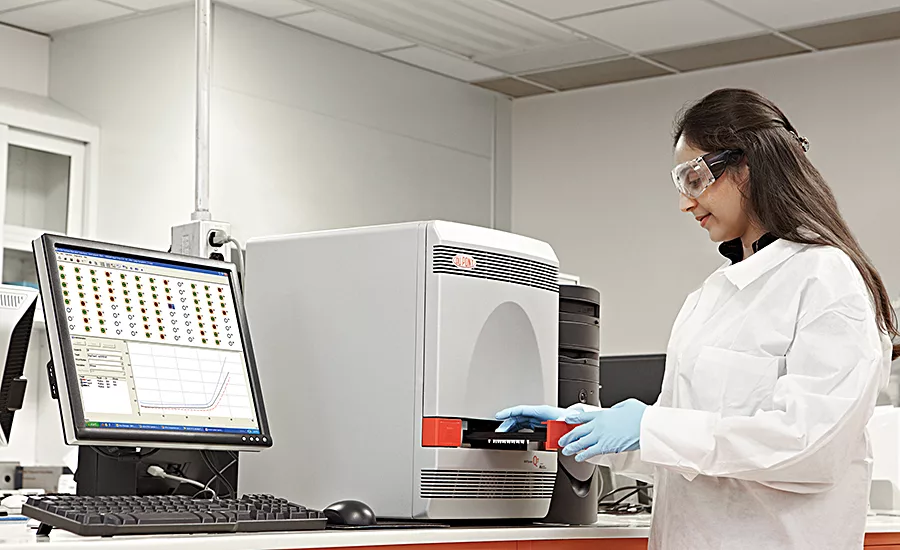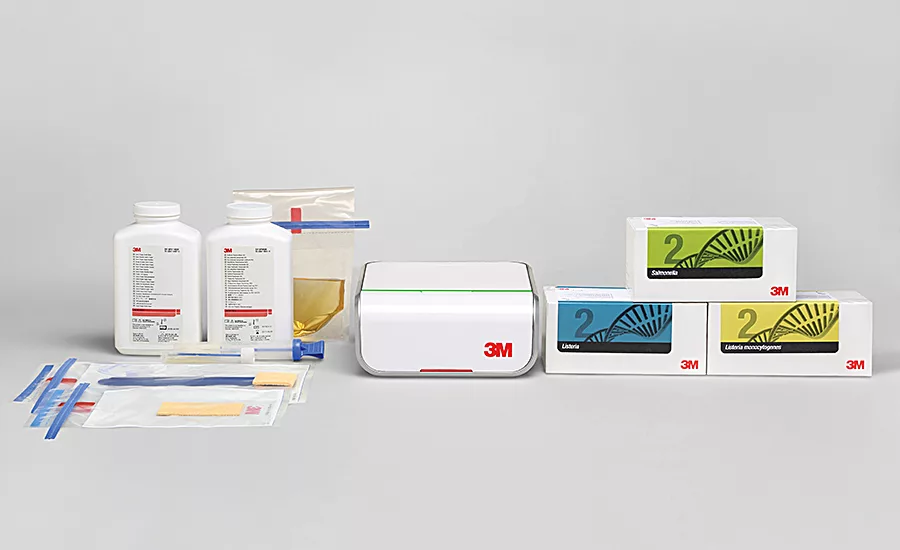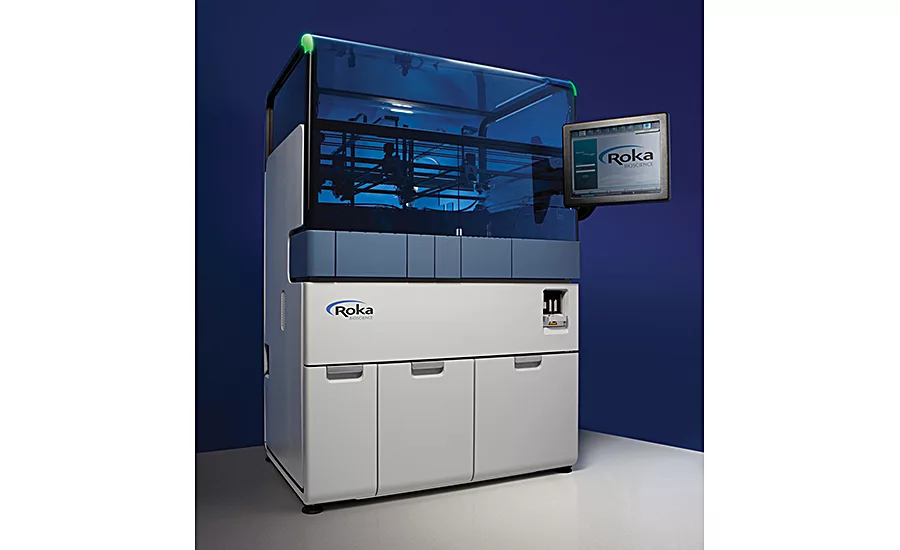Food Safety
Battling pathogens in produce
Produce is increasingly becoming associated with foodborne illnesses due to a growing number of reported outbreaks.


The DuPont BAX system detects pathogens in various food types and production environments. Source: DuPont.

3M molecular detection assays detect L. monocytogenes and Salmonella. Source: 3M.

The Atlas system detects molecular pathogens, including Listeria, Salmonella, E. coli and other organisms commonly implicated in food contamination. Source: Roka Bioscience.
Food writer Michael Pollan’s famous mantra, “Eat food, not much, mostly plants,” seems to have made an impact on consumers who are demanding fresh produce. In fact, many in the food industry are predicting 2016 will be the year of the vegetable, with “farm to fork” movements and the “flexitarian” diet gaining strength.
However, fresh fruit and vegetable operations are coming under greater scrutiny. For instance, new Food Safety Modernization Act (FSMA) rules have established for the first time enforceable safety standards for produce farms and hold importers accountable for the safety of their food.
According to the Centers for Disease Control and Prevention (CDC), an estimated 48 million Americans (one in six) get sick from foodborne illnesses each year. Consequently, FSMA rules are aimed at preventing problems rather than reacting to outbreaks. For example, the Produce Safety rule sets food safety standards for businesses involved in produce production, including growing, harvesting, packaging, etc.
FSMA standards are designed to help minimize the risk of illness from foodborne pathogens and include requirements for water quality, employee health and hygiene, and equipment and tool sanitation. While the Foreign Supplier Verification rule requires food importers to operate at the same level of food safety as US suppliers, the Accredited Third-Party Certification program establishes auditors to conduct food safety audits and certify foreign food facilities meet FDA safety requirements.
Considering the increased consumer demand for fresh produce and greater scrutiny from regulatory agencies, fresh fruit and vegetable processors must understand what and how foodborne pathogens can be present in a facility. They also must have preventative measures in place to protect food quality, such as best practices in food safety management and the best pathogen detection solutions.
Foodborne pathogens
In February 2015, the Interagency Food Safety Analytics Collaboration (IFSAC) Project released its first report, “Foodborne Illness Source Attribution Estimates for Salmonella, Escherichia coli O157 (E. coli O157), Listeria monocytogenes (Lm), and Campylobacter Using Outbreak Surveillance Data.” IFSAC is a collaboration between the U.S. Food and Drug Administration (FDA), the U.S. Department of Agriculture’s Food Safety and Inspection Service (USDA/FSIS) and the CDC.
IFSAC analyzed data from outbreaks caused by Salmonella, E. coli O157, Lm and Campylobacter reported to CDC’s Foodborne Disease Outbreak Surveillance System from 1998 to 2012. The data revealed 36 percent of E. coli O157 illnesses were attributed to vegetable row crops, 50 percent of Lm illnesses were attributed to fruits and, for Salmonella, illnesses were attributed to seeded vegetables (18 percent), fruits (12 percent) and sprouts (8 percent).
Among foodborne illnesses, Listeriosis is considered the most serious. Even though it is not the most common, it can have mortality rates as high as 20 to 30 percent, according to the University of California’s Division of Agriculture and Natural Resources.
E. coli and Salmonella are carried in the intestinal tracks of animals. Lm can also survive in the gastrointestinal tract of some animals, but is more commonly found in soil samples than Salmonella and E. coli.
“For produce, two major points of contamination are contaminated irrigation water or contact with fecal contamination from birds or other wild animals, so controlling these factors is critical,” states Seth Blumerman, research investigator for DuPont Nutrition & Health’s Diagnostics. “Growing and harvesting practices that minimize contact with animal contamination should be implemented, and irrigation and wash water sources should be demonstrated to be free from contaminating pathogens and possibly include antimicrobials.”
According to the United Fresh Produce Association, L. monocytogenes is easily transferred in production environments and has been found in harvesting equipment, packing houses, packaging equipment, drains, floors, walls, forklifts and more. It can be hard to kill and can survive harsh conditions other pathogens cannot. For instance, it can grow at temperatures below 40°F and does not require oxygen to survive and grow, meaning it can flourish in packaged products.
“Different pathogens can contaminate a processing facility through different channels,” Blumerman says. “For example, HVAC equipment or recessed machine housings on processing equipment can harbor Listeria. Salmonella, on the other hand, is more likely to be brought into a facility through contaminated ingredients.”
Thus, it is imperative to set in place a number of preventative methods and processes that can detect pathogens in a facility before they contaminate food and to ensure these practices are effective.
Minimizing microbial food safety hazards
The best way to prevent a contamination problem is to minimize the risk of pathogen entry into a facility. “To do that, you must have systems in place that provide supplier visibility. They also should enable you to schedule supplier risk assessments and audits. You can use the data from these to help determine what food safety programs to put in place,” offers Brandon Henning, director of industry solutions for Sparta Systems.
Some processors require their raw produce suppliers to produce a certificate of analysis (COA), confirming the product is free of pathogens and meets its standards. “When establishing a certificate of analysis program, consider the accuracy and sensitivity of the test method you will be utilizing,” says Erin Dreyling, vice president of commercial support for Roka Bioscience. “Suppliers also should consider providing their clients a list of analytical methods that have been deemed acceptable for testing.”
However, since pathogens can get into a facility in a myriad of ways, the first line of defense is a food safety management plan with effective cleaning and sanitation procedures. This is particularly important for facilities handling fresh produce that does not undergo a kill step.
“Pathogens can be introduced into produce by employees and from the environment surrounding the facility,” says Wilfredo Dominguez of 3M’s professional service division. “Therefore, good manufacturing practices, including proper facilities and equipment design, are essential to maintain the quality and safety of the food.”
Assessing vulnerable areas in a plant can be helpful in identifying sources of pathogens. These areas include entryways where materials are received, wet areas and places where workers and/or equipment goes in and out of raw and processed produce areas.
“The produce industry will likely need to institute some of the controls currently in place in the meat industry, including regular environmental monitoring procedures, equipment design that reduces the likelihood of contaminating processing machinery and facility design that separates raw materials from finished products,” explains Jun Li, research investigator for DuPont Nutrition & Health’s Diagnostics.
He adds that a facility design that minimizes the number of inaccessible spaces and amount of immovable equipment and allows easy, effective sanitization is particularly important in reducing the risk of pathogen contamination. Special attention also should be paid to areas that can become wet and not frequently cleaned, such as cracked floors, drains and absorbent material in items like anti-fatigue mats.
Product testing alone is no longer considered sufficient for detecting pathogens. Instead, establishing an environmental monitoring program to test a number of locations is recommended to detect problematic areas and equipment in a plant.
“Today, environmental monitoring is rapidly taking over and will be highly enforced in certain food processing facilities through FSMA,” says Dominguez. “The rationale behind this is that by monitoring the environment in which the product has been processed, one can prevent the contamination from ever occurring. An environmental monitoring program is designed to search and destroy niches where pathogens exist and, probably more important, where they could potentially hide.”
Environmental monitoring program
According to the United Fresh Produce Association report, “Guidance on Environmental Monitoring and Control of Listeria for the Fresh Produce Industry,” an environmental monitoring program has four objectives. The first is to prevent the spread of pathogens in a facility, the second is to verify the control measures are effective, the third is pathogen detection, and fourth, if a pathogen is detected, determining the appropriate corrective action.
“An environmental program must be designed with the right food safety culture mindset to start,” according to Dreyling. “The crucial piece is developing procedures that can find the pathogen, look in the hard-to-reach areas, are comprehensive and use the right technology.”
First, the program should be designed to include samples from throughout the production process. One of the common ways to do this is through setting up sanitary zones and sampling from each of them, says Sparta Systems’ Henning. These zones are as follows, with one being the riskiest and four being the least risky:
- Zone 1—Areas and surfaces where product is exposed to equipment and the environment before final packaging; this could include tables, conveyor belts, fillers, etc.
- Zone 2—Sites near or next to Zone 1 surfaces, such as the exterior housing of equipment, control buttons, drip shields and pans
- Zone 3—Non-product contact surfaces in processing areas, such as floors, walls, doors and drains
- Zone 4—Areas surrounding the processing location, such as locker rooms, offices, maintenance areas and warehouses.
“The advantage of such a program is that if it is executed effectively, it ensures you do not just focus on bacterial mitigation in high-risk areas, but the entire facility,” observes Henning. He adds having quality management software in place will help with the enforcement of environmental monitoring programs by notifying supervisors if tasks are not done or out-of-spec results are found.
Determining where and how many samples should be taken within each zone can vary according to the processing environment and facility design, since each has different microbiological risks. “Each company’s QA/QC specialists, engineers and microbiologists should do a complete evaluation of a facility to determine the areas where contamination is most likely to occur,” says Li. “These sites then form the core of a sampling plan, with other areas sampled less frequently.”
Dominguez suggests doing more testing in the initial phases of the environmental monitoring program to identify problematic areas and set baseline values for indicator organisms. However, choosing the right testing method is crucial.
“The testing methods used for environmental monitoring can be divided into two categories: pathogen testing and indicator organism testing,” Dominguez says. “Testing for pathogens enables the identification of the specific threat.”
Salmonella, E. coli and L. monocytogenes are the pathogens most commonly tested for in ready-to-eat produce. To identify them, selective growth agents, biochemical differentiation, immunological classification and/or DNA identification may be utilized.
“Rapid methods, which are essential in the case of produce due to its short shelf life, typically involve an enrichment step where a single cell can be multiplied to generate millions of copies or more,” says Dominguez. “The enriched sample can then be analyzed to detect the presence of the target pathogen.”
However, while this kind of testing detects pathogens, it is dependent on the quality of the sample and can be expensive. DuPont’s Blumerman believes a test method should be designed so it does not affect processing throughput or become inconvenient to perform. For instance, the DuPont BAX system automates many of the preparation and detection steps and provides a variety of validated protocols to enhance a wide range of facility workflows. This system also helps minimize the test results’ response time.
“It’s no good waiting days for results if the product is out the door and consumed within days,” states Alan Traylor, business manager for MOCON. “Rapid methods hold a lot of promise to shorten decision-making. Another approach is to perform pathogen testing only on suspect lots. Screening tools, such as total plate count or total coliforms, are used to identify critical lots.”
A less expensive alternative to pathogen testing, indicator organism testing can be used to guide where interventions should take place, says 3M’s Dominguez. One example of this type of testing is aerobic plate count (APC), which allows the growth of many different organisms to give an overall idea of the microbiology of a tested area.
“Arguably, feces are the vehicle of all foodborne pathogens. They can be present in the water supply, on the hands of workers or in the product itself,” Dominguez adds. “Since small quantities are very hard to identify, looking for organisms present in an environment is a practical alternative.”
According to Roka Bioscience’s Dreyling, produce processors should only use testing methods validated by a certification body, such as the Association for Analytical Communities. The methods also should be able to accurately detect low levels of pathogens and produce rapid results to inform timely decisions.
“Test methods for produce must be highly robust across matrices, which have high background flora levels and/or other challenging characteristics,” Dreyling adds. “Many detection methods do not offer the sensitivity or accuracy necessary to develop an effective plan and provide producers with a ‘cloudy’ view of their current situation.”
Only using the right tools can achieve the microbiological steps of “seek, discover, destroy” to successfully battle pathogens.
Remediation efforts and recall
Of course, plans and preventative procedures are meant to keep processors one step ahead of contamination. However, it is likely detection of a pathogen is more a question of “when, not “if.” “The goal of any effective monitoring plan is to catch contamination before a complicated—and costly—remediation or product recall occurs,” says Blumerman.
According to Sample 6’s “Pathogen Remediation in 8 Steps,” if a test result comes back positive, the first step is to confirm the location and communicate the findings to all key personnel. Next, the product should be contained, and a remediation team should be assembled to address the problem, find the root cause and perform corrective actions. “Eliminate the environment where the pathogen was found,” says Dominguez. “This can include deep cleaning, a redesign of equipment and facilities, and/or retraining workers.”
Then, more environmental testing should be done to ensure the remediation efforts, no matter how simple or complex, have been effective. If they have not been, an investigation team should look into the suspected area and possibly perform an audit of sanitation practices or conduct a food safety refresher course for employees. Finally, processors should review each incident and work to prevent a similar event from happening in the future. “This might involve looking beyond the walls of the processing facility, taking a closer look at records and getting more involved with suppliers,” says Dominguez.
The big question is when to recall a product. Li suggests companies clearly define their recall criteria before the issue arises to avoid making tough decisions during the stressful and time-sensitive period after contamination is discovered. “Contamination events not directly related to finished products may indicate the need for additional testing of product before it’s released to the market, but may not necessarily require a recall,” Li says. “If contamination is found in finished product, and the product will not be cooked or otherwise prepared in a way that would kill the bacteria, then the situation presents a strong case for issuing a recall.”
For more information:
Alan Traylor, MOCON, Inc., 763-493-6370,
info@mocon.com, www.mocon.com
Nicolette Kerr, DuPont Nutrition & Health, 302-695-1369,
nicolette.kerr@dupont.com, www.fooddiagnostics.dupont.com
Wilfredo Dominguez, 3M, 651-592-903,
wdominguez@mmm.com, www.3m.com/foodsafety
Erin Dreyling, Roka Bioscience, 908-605-4700,
customerservice@rokabio.com, www.rokabio.com
Alicia Brown, Sparta Systems, 609-807-5100,
alicia.brown@spartasystems.com, www.spartasystems.com
Looking for a reprint of this article?
From high-res PDFs to custom plaques, order your copy today!







